41 years ago today, EMI released David Bowie’s 15th studio album Let’s Dance. The album became Bowie’s greatest commercial success, with 11 million albums sold and topping the charts in 9 countries. For many Bowie fans, his persona, lyrical content, and performance in Let’s Dance remain the most iconic of his long career, not least because of the substantial radio play it received. READ some quick facts about this timeless work of art… (1983)

The sessions featured players from Producer Nile Rodgers’ band Chic and the then-unknown Texas blues guitarist Stevie Ray Vaughan on lead guitar. For the first time ever, Bowie only sang and played no instruments.
Ironically, Bowie would later reflect poorly on the period that included Let’s Dance, Tonight, and Never Let Me Down, referring to it as his “Phil Collins years”.
Accompanying the album was the Serious Moonlight Tour. It was another massive success— the biggest tour of 1983, and it appeased Bowie’s newfound audience as well as turned him into a massive superstar. But much like the album, he was unsatisfied with the tour, turning him as he saw it into something he was not, and did not want to be: a perfectly popular and commercially successful artist and performer.
MORE Good News on this Date:
- Harriet Tubman began her Underground Railroad, helping slaves to escape (1853)
- In Gothenburg, Sweden, the first Volvo automobile is unveiled (1927)
- Ampex Corp demonstrated the first commercial videotape recorder, which would, among other things, lead to an explosion of television news gathering (1956)
- President Richard Nixon ended a blockade against China (1971)
- The United States Supreme Court ruled that people may refuse to display a state motto on their license plate—by taping over it, for instance (1977)
- The Soviet Union pledged, at a UN ceremony in Geneva, to withdraw its troops from Afghanistan (1988)
590 years ago today, the foundation stone for the Cathedral of St. Peter and St. Paul, in Nantes, Brittany, was laid. Like many of the grandest cathedrals on the continent, from the moment that stone was well-cemented in its place, it would be many generations before anyone would see the finished product. That’s because it took 457 years to finish.
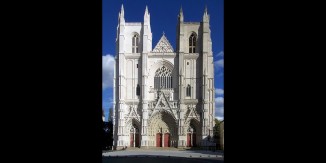
If one were to describe the Nantes Cathedral in a few words, one would inevitably be white. The lack of the traditional painting, colored marble, and other decorations so ubiquitous in catholic churches in Italy or Southern France left the Nantes Cathedral mostly greyish-white.
The second word to describe it would be gargantuan. Something about the monotone interior draws the gaze up above the massive columns to the galleries above the archways and really presents the sense that the structure was not erected for man, but for something much larger.
Brittany being a strong and independent-minded province of France across the view of history, the interior is decorated with tombs and monuments to the provinces’ most revered generals, dukes, bishops, and others. (1434)
124 years ago Today, Exposition Universelle opened in Paris, the World’s Fair to end all World’s Fairs. 40 nations and dozens of then-colonial territories exhibited their cultures, technological and scientific advancements, and architecture, and the Paris architects built the Grand and Petit Palais, Alexander the III Bridge, the Gare d’Orsay railroad station, and a very large, four-legged tower made of iron…
A celebration of the achievements of the past century, during which the human species enjoyed one of the most rapid accelerations in the standard of living ever achieved, and in which nearly every major device that runs our society today was first built, it was a titanic undertaking and ran from April to November.
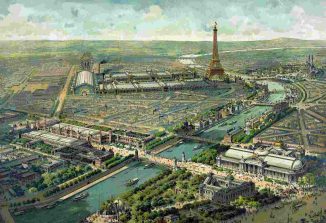
Planning for the 1900 Exposition began in 1892, under President Carnot, with Alfred Picard as Commissioner-General. Three French Presidents and ten Ministers of Commerce held office before it was completed. President Carnot died shortly before it was completed. Though many of the buildings were not finished, the Exposition was opened on 14 April 1900 by President Émile Loubet.
By then, many of the invited nations had created what were called “pavilions” but were actually brick and mortar, wood and shingle and glass palaces, castles, and national museums to house expositions of their cultures, handicrafts, and art. The fair was of such monster proportions that 440,000 pounds of oil were consumed per hour to keep the electric lights on.
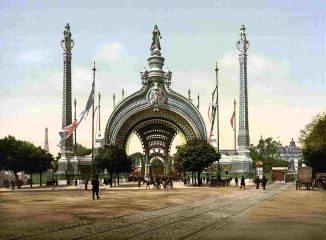
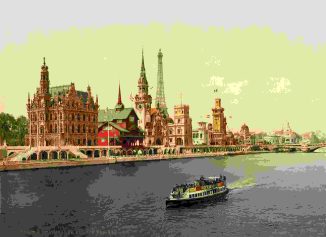
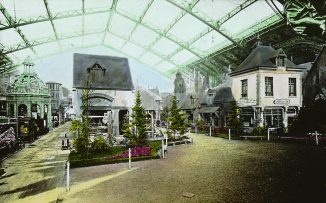
There were motion pictures, giant fountain displays, a huge Ferris wheel, the world’s largest telescope, an entirely simulated passenger cruise trip from France to Turkey complete with weather, a giant conveyor belt walkway, electric cars, diesel engines, the first ever trolleybus line, the first ever magnetic audio recorder, and if all that wasn’t enough, there was the Eiffel Tower, and the 1900 Summer Olympics.
When all the celebrating was done, most of the structures were demolished, and raw materials sold. Some of the pavilions were relocated, others were kept, and some were brought back and resembled in their home countries. (1900)
43 years ago today, the first NASA Space Shuttle made a picture-perfect landing on a desert runway demonstrating the genius a reusable rocket.
Columbia, successfully launched two days earlier on the 20th anniversary of the first human spaceflight (Russia’s Vostok 1), orbited the Earth 36 times before making its beautiful ‘unpowered’ landing on the dry lakebed runway at Edwards Air Force Base in California.

The maiden voyage was commanded by John Young, a veteran from the Gemini and Apollo programs who, in 1972, was the ninth person to walk on the Moon, and was piloted by first-time astronaut Robert Crippen. Five years into its service, Columbia also carried the first sitting member of Congress to venture into space, Bill Nelson.
Named after the command module of Apollo 11 (the first crewed Moon landing), Columbia went on to serve for over 22 years, completing 27 missions in space, before a second accident led to the retirement of all five of the Space Shuttle orbiter vehicles: Enterprise, Challenger, Discovery, and Atlantis in 2010. Together, they flew a total of 135 missions over 30 years, launching satellites, interplanetary probes, and the Hubble Space Telescope. They also participated in the Shuttle-Mir program with Russia, and served as a delivery vehicle for the International Space Station.

One of the fascinating things about the Shuttle fleet occurred after they landed—the orbiter would be flown back to the Kennedy Space Center on the back of a specially modified Boeing 747 jet. (1981)
And, 158 years ago today, Anne Sullivan was born, the gifted teacher of the blind who famously broke through to Helen Keller and taught her how to speak and read and write.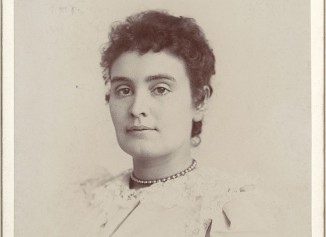
Sullivan lost most of her eyesight to disease while growing up, which made it easy for her, at age 20, to relate to her famous pupil. Their story was portrayed in the 1962 award-winning film The Miracle Worker, based on The Story of My Life, the 1902 autobiography of Helen Keller, including the breakthrough moment when Keller learned the words CAKE and DOLL. (1866)

Also, 21 years ago today, the Human Genome Project announced it had finally reached its goal of sequencing the 3 billion DNA letters in the human genome. Considered to be one of the most ambitious scientific undertakings of all time—even compared to splitting the atom—Dr. Francis Collins led the 13-year international project coordinated by the U.S. government. All the data from the unique collaboration was published online–for free to anyone, even though it cost $3 billion in mostly U.S. funding. Thanks to the work of these one thousand scientists, we now have a way to target cancer and other diseases without harming healthy cells.
Collins, the American physician-geneticist had earned a reputation as a ‘gene hunter’ earlier, when he discovered the specific genes associated with a number of diseases. He later wrote the New York Times bestseller, The Language of God. (2003)
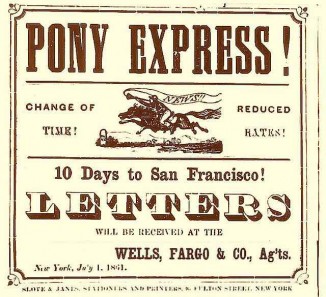
On this day 164 years ago, the first Pony Express delivery arrived at its San Francisco destination eleven days after departing St. Joseph, Missouri—a delivery time that many said was impossible—establishing a speedy transcontinental service for newspapers, mail, and small packages. The legendary service employed 120 riders, 184 relay stations, 400 horses, and several hundred personnel at its peak, to carry the mail approximately 1,900 miles across the Great Plains, over the Rocky Mountains and the Sierra Nevada range.
Vital for the new state of California, the Pony Express service drastically reduced the travel time for messages between the Atlantic and Pacific coasts, and William Cody, aka Buffalo Bill, was one of their best riders. Cody, just 16 years old, once rode 322 miles in less than 22 hours using 21 different horses, after a relay rider had been killed. Seven months later, California’s newspapers received word of Lincoln’s election only seven days and 17 hours after the East Coast papers, an unrivaled feat at the time.
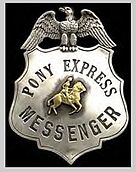
Upon employment, each driver was presented with a special edition Bible upon which they were to swear that during their engagement, they would “under no circumstances” use profane language, drink intoxicating liquors, quarrel or fight with any other employee of the firm—and in every respect conduct himself honestly and faithfully to his duties to win the confidence of his employers. (1860)

And, 85 years ago today, John Steinbeck’s Pulitzer Prize-winning novel The Grapes of Wrath was published, a story he wrote after interviewing displaced migrants who escaped the Dust Bowl (a period of severe dust storms that greatly damaged the ecology of the Midwestern prairies during the 1930s and the Great Depression). The book won the National Book Award and the Pulitzer Prize for fiction and soon after was made into a celebrated Hollywood film starring Henry Fonda.
Called the Great American Novel, it was also likely the most thoroughly discussed and debated story in 20th-century American literature. At the time of publication, Steinbeck’s book was a phenomenon on the scale of a national event—selling out everywhere, in high demand.
The novel focuses on the Joads, a poor family of tenant farmers driven from their Oklahoma home by drought and bank foreclosures forcing farmers out of work. Due to their nearly hopeless situation, and in part because they are trapped in the Dust Bowl, the Joads set out for California, along with thousands of others seeking jobs, dignity, and a future. WATCH a video… (1939)
SHARE the History Gems…



















